| |
It
will be 10 years ago this June that Men.Style.com first posted Scott
Schuman’s images of showgoers at Milan’s Spring 2007 men’s collections
and the fashion industry’s obsession with street style began. Back
then, The Sartorialist, as Schuman had dubbed his blog and he became
known, had the territory almost all to himself, save for a few other
intrepid upstarts, including Face Hunter’s Yvan Rodic, Jak &
Jil’s
Tommy Ton, and Street Peeper’s Phil Oh. But it wasn’t long before the
streets outside the men’s and women’s shows were thronged with
photographers angling for images of editors, retailers, and other
influencers. As Vogue.com contributor Trace Barnhill so eloquently put
it: As the Paris Tuileries and New York’s Lincoln Center turned into a
minefield of professionals, amateurs, and iPhone-wielding tourists,
“we’ve loved street style, we’ve hated it, we’ve loved to hate it, and
we’ve hated to love it.”
These days, street style is its own
cottage industry, generating hundreds of millions of fashion month
clicks for sites like Vogue.com, supplying content for old media, and
making sales for fashion brands. Also: The street style phenomenon has
lately engendered a cadre of self-made stars, à la The Blonde Salad and
Gary Pepper Girl, who’ve virtually eliminated the photographer from the
equation and are producing street style selfies with their own in-house
teams. In the process they’re turning their personal blogs into fully
fledged online lifestyle magazines and landing super-lucrative side
gigs as brand ambassadors, even designers.
I chatted with some
of the industry’s major players to talk about the early days; the
circa-2013 backlash; the backlash to the backlash; and, in the era of
Instagram and Snapchat, what street style’s next 10 years could look
like.
|
The
New York Times had been publishing Bill Cunningham’s street photography
for decades, but in 2006 Scott Schuman and co. represented a new breed
of street photographer, using the fledging online blog format as a
platform for their work.
THE SARTORIALIST’S SCOTT
SCHUMAN: I remember getting the call from Men.Style.com in June. “Do
you want to go to Milan for us?” Yes! Yes, yes, yes. This was my big
break. I was a stay-at-home dad and a self-trained photographer doing a
blog at a time when no one understood anything about blogs, so I knew I
had to make an impact right away. I called a friend because I had no
money—really no money—and he let me borrow $20,000, and I spent half of
it on a camera and laptop and half on clothes. I knew if I wanted to
stand out, I had to act like a photographer and look like an editor. I
had to confuse people, and that’s exactly what happened
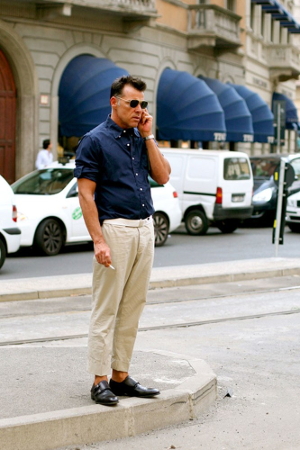
FACE
HUNTER’S YVAN RODIC: My first Fashion Week was September 2006. People
were almost surprised to be photographed. It was something so much more
low key, and [there was] less business around it.
STREET
PEEPER’S PHIL OH: It was 2006 when I started my blog. I’d hang out in
front of Seven on Orchard Street and wait for someone cool to come and
take their picture. I’d go to Tokyo and hang out in Shibuya outside
this consignment store for eight hours and get maybe 15 photos. It
wasn’t about photography—I had this shitty point-and-shoot camera. It
was still pretty innocent. Then an ad agency contacted me out of the
blue. Puma liked my blog. When they told me how much they were going to
spend on the ad buy, I wasn’t sure if there was a typo, if there wasn’t
an extra zero on the number. But I didn’t ask. When the check came and
when it was $30,000, I thought, Oh, my God, maybe I can turn this into
a real job.
TOMMY TON: I started shooting in February 2007.
Scott’s not necessarily the one that drew me in. It was more the
Japanese with how detail-oriented they were. You know how they are with
their notepads, from head to toe what you are wearing. That’s more what
drew me in.
SHOICHI AOKI, founder of Tokyo’s Street, FRUiTS, and
Tune magazines: Starting in the mid-’90s I decided to record street
fashion as the art of humans, the same way music and painting are
recorded. I’ve never minded who the subject is, I’m concerned about how
cool it is. The way I shoot, it must be documentary. It must be cool.
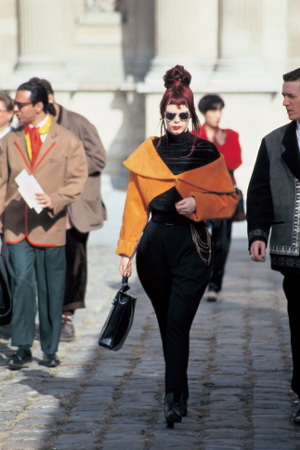
|
| |
From
the start, the new crew tried to distinguish themselves with unique
shooting styles. Though they were often photographing the same people,
their approaches were different.
SCHUMAN: I never thought
of myself as a photojournalist. I wanted to shoot in a romantic way. I
wasn’t trying to tell the truth necessarily. If the light wasn’t good,
I’d move them around.
TON: Scott glamorized the idea of portrait
street photography. My images were all horizontal. People were kind of
like, What? The fact that everything was cropped tight or focused, it
was something different. It was the time of Nicholas Kirkwood and
Rodarte shoes, everything was so sky high in terms of footwear. And the
accessories! There was a lot of eye candy to shoot.
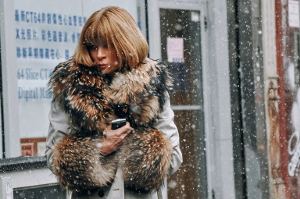
OH:
I really like when there are other people in the background or to the
sides. These fashion shows are happening in a city where everyday life
goes on. People are still going to Duane Reade, people are going to
school. Gawking tourists in the background make me so happy. Getting an
odd picture is worth more to me than getting the picture that everyone
else has.
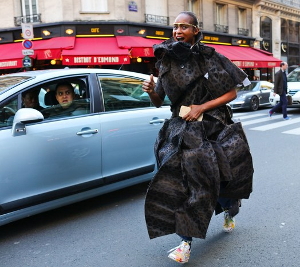
LE
21ÈME’S ADAM KATZ SINDING: I get a lot closer to my subjects than other
photographers. I don’t have nearly as much negative space—that’s a
response to the environment. Tommy uses a much longer lens than me. I
don’t zoom with my lens, it’s fixed focus. Wherever my feet are, that’s
the frame.
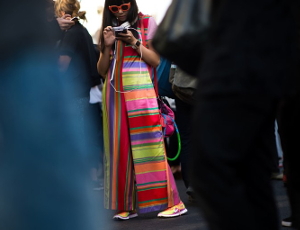
|
|
It’s hard to remember now with
cameramen everywhere, but in the early days, street style was an
isolating, even lonely job.
OH:
Tommy taught me a lot about fashion. We had very little in common
except for what we were doing. He was a die-hard fashion obsessive, and
I knew Moschino because it was in that Biggie Smalls song: “I put hos
in NY onto DKNY. Miami DC prefers Versace.” Tommy was like, “You don’t
know who Nicolas Ghesquière is?” “No. Is he a rapper, too?”
|
|
The relatability factor was
reason number one for street style’s early popularity.
TON:
When you’re able to see fashion on a face that’s more relatable, it’s
not manufactured, so it feels more accessible. I think that’s why
street style blew up. Everybody loves beautiful models, but it’s when
there’s a personality behind it, that’s when the look comes to life.
In
September 2009, Dolce & Gabbana put Scott Schuman, Tommy Ton,
Garance Doré, and Bryanboy (aka Bryan Grey Yambao) in the front row at
its Spring 2010 show. Suddenly, the photographers who had been shooting
editors and buyers outside the shows were taking up seats that once
belonged to their subjects.
GARANCE DORÉ: Our generation of
bloggers, we were not trying to take the space of other people; we were
interested in giving our point of view. It was very splashy of Dolce.
SCHUMAN:
They put these computers in front of us. The four of us were like,
“They’re trying to show they’re hip, they’re onto what’s happening.”
But we don’t sit at our computers and download while a show is
happening. I had to ask them not to put the computers in front of us
for the D&G show [later that week].
TON: The first season I
shot for Style.com was when the Dolce thing was happening. Fashion was
becoming more democratic. It wasn’t so exclusive; it became more
inclusive at that point.
|
|
Print magazines soon figured out
how to put this mostly online phenomenon to work for them.
OH: It’s much cheaper to buy a street style picture than it is to
produce a shoot to illustrate a trend.
It’s
difficult to pinpoint a precise moment when street style exploded, but
we’d place it some time between when Tommy Ton signed on with Style.com
in 2009 and Suzy Menkes’s New York Times takedown of the phenomenon in
2013.
OH: I don’t begrudge other photographers even if there are
already 1,000 of us. It means there’s a business here. There’s income
involved. If there were no wannabes, that would mean there was no
income, which means we’d still be doing this for free. It’s a
by-product of the success.
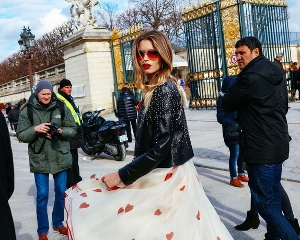
SCHUMAN:
I relate it to the sports world. Of all the people outside the shows
over the years, only a few of them have made money and done it
consistently. But they love fashion. Before, when it did feel very
insular, they’d have had no reason to go talk to Anna Dello Russo. Now
they can pick up a camera and go talk to their hero. ADR is the Michael
Jordan to these young fashion people. The downside is, it’s so easy to
share images now that there are just so many bad images out there.
SINDING:
Everybody’s bummed with how many photographers there are now. I use it
as a kick in the ass to make me work. If it was easy, how it used to
be, I would’ve grown bored. But now I’m forced to run faster, work
harder, risk more, like running through traffic.
|
|
In
2013, the International Herald Tribune_’s Suzy Menkes wrote a buzzy
piece for_ The New York Times about the “circus of street style.”
TON:
I didn’t have a reaction. I thought, I’m just going to keep doing what
I’m doing. Suzy’s not a subject being photographed, she’s a woman
respected for her talent, not for her image. It’s easy to criticize
from that perspective and not understand that street style is another
way to market yourself, and that it can open so many doors.
OH:
The article hurt, it actually really hurt. Early on I would get the
side eye from industry people. Once street style became accepted, I had
one foot in the door of the fashion industry, it felt good. But like
all good things, there will eventually be a backlash. When the Suzy
piece came out, the mood changed overnight. All of a sudden people were
like, “Oh, no, street style has become too much. It’s so manufactured.
It’s so fake. Oh, my God, it’s so over.”
|
|
On the phenomenon that is Anna
Dello Russo:
SCHUMAN:
There are some people who are extravagant, but they do it with such a
sense of sincerity it doesn’t bother me. That’s one of the reasons I’ve
always loved ADR. She’s crazy, but she’s sincere.
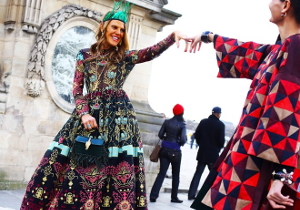
|
|
The
backlash was short-lived. Since Menkes’s article, street style has
flourished, aided and abetted by the arrival of Instagram. It makes for
an often-crowded, even chaotic and sometimes dangerous scene outside
the shows.
SCHUMAN: If they did all that running around
and the pics were great, I’d think, Oh, it’s worth it. But the pics
aren’t great. The cropping’s weird, the exposure’s off. I don’t think
who they’re picking to shoot is that great. All that hullabaloo.
OH:
The new wave, a lot of them have a list of people that they need to
get. Most of them, the vast majority don’t have an interest in fashion,
or even if they do, they don’t have a refined eye. They treat the whole
thing like a video game, not respecting people’s space, knocking people
out of the way—“Hey, you, move out of the way. Hey, you, background!
Move!” I heard them yell that at Angelica Cheung [the editor in chief
of Chinese Vogue].
TON: It’s become more stressful. I twisted my
ankle this season because of it. At the beginning it was fine, but now
everyone worries for everyone’s safety. The cars that drive by are
sometimes reckless, and there are some photographers who have a
complete disregard for traffic or bystanders.
DORÉ: These days
it’s just a red carpet system. Somebody poses and you have a wall of
100 photographers taking the same exact shot. It’s definitely not how I
started, and it’s not how I like to do it.
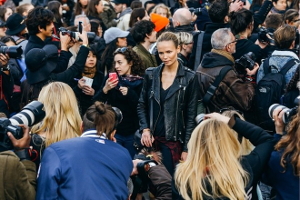
OH:
I’m pretty friendly. I smile and wave. I know how aggressive the whole
thing is. I feel bad when industry people have to cross the gauntlet of
photographers. To always be subject to judgment from men, strangers,
must be, I don’t know. I try to lighten the mood, let’s say.
|
|
It’s
true: Many, if not most street style photographers are men. Women
street style photographers (see Hanneli Mustaparta, Tamu McPherson)
often do double duty behind and in front of the camera.
STYLE
FROM TOKYO’S REI SHITO: I’ve found that as a woman people are more
willing to stop and share a moment with me. They seem more natural and
less intimidated by me.
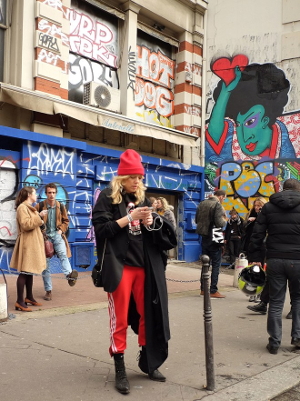
DORÉ:
I never think about the fact that I’m a woman, but street style to me
has always been a personal story. Women would come and talk to me. I
started knowing people, that made it easy for a few years, even as it
was becoming crowded, to try to get the best photo that I could. So
yeah, it probably got me some lucky moments. People were willing to
play along with me. They trusted that I would show their best profile.
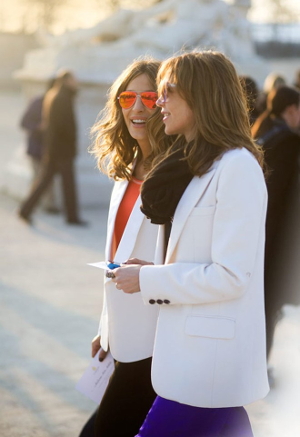
SHITO:
I think other photographers look to shoot the most photogenic situation
of famous people at the shows, but I focus my shooting on fashion,
which I personally like, and people who have a different aura or a
unique mood. Because of this, I find I shoot a variety of people.
That’s how I differentiate myself from others.
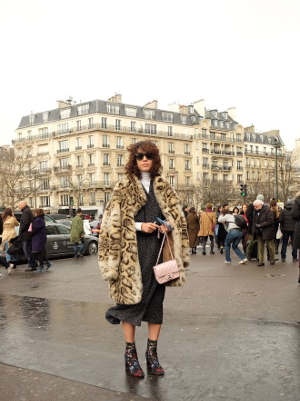
|
|
On the rules of engagement:
TON:
My funniest rule is avoid us at all costs. The moment that a girl stops
and keeps posing for everyone, it makes her less desirable. If she runs
away from us, we’ll jump over cars and do whatever we can to get her
picture.
|
|
In the early days of street
style, editors in chief and fashion directors were the top quarry. Now
it may be models.
OH:
Before, it was much more difficult to get shots of models, but now that
social media is important for their careers, the agencies have
encouraged them. I’m sure they’re styled a bit. They could do a better
job, honestly. That’s why I appreciated those few rare models like
Hanne Gaby [Odiele] or Caroline Brasch Nielsen. She came back this
season and did a few shows—she’s always been one of the coolest.
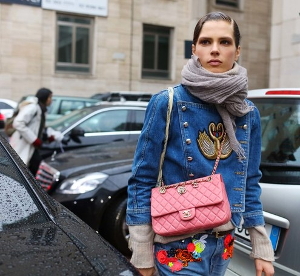
SCHUMAN:
I like real girls, not that models aren’t real girls, and some of them
have good style. But I do think it’s a bit easy. She’s 6-foot-3, super
skinny, she’s having a lot of clothes given to her. I don’t really
shoot celebrities much, either. For me there’s no mystery in it.
|
|
On playing favorites:
OH:
I’m guilty of having favorites. If I ever see Gio [Battaglia], ADR,
Susie [Lau, aka Susie Bubble], Sofía Sanchez de [Betak]—even when
they’re wearing nothing, they still look good. Although, when are they
ever wearing nothing? I’m obviously drawn to fun things, color—it’s
just a personal response. It’s either “Aha!” or “Nah.”
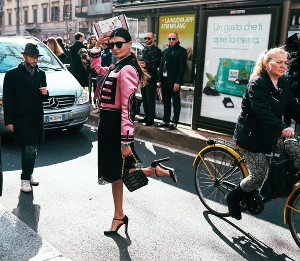
TON:
The type of woman that intrigues me is the Milanese woman. I love that
Marni and Prada woman, the twisted intellectual whose sense of style is
very individual. I’ve told junior editors, “Stop borrowing clothes and
wear your own clothes, that’s the reason we fell in love with you.”
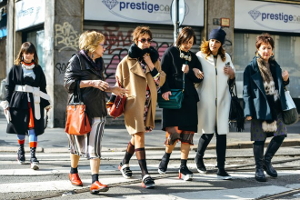
|
|
Just as the photographers are
mostly male, the most popular subjects
are mostly women. But the menswear shows are a busy time for street
style, too.
TON: Guys have tricks. They’ll show up on a bike.
They’ll arrive in a group. They’ll all wear suits and strut up and down
the street in a squad, and the thing is, they’re not even going to the
show.
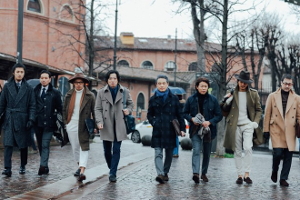
|
|
If
some insiders have been turned off by street style, it’s not just the
throngs of photographers that are to blame. It’s the way brands have
co-opted it, too.
RODIC: It took some time, but brands
have embraced [the fact] that people are going to be photographed. As
street style blogs became powerful, it made sense [for brands] to put
as much effort into guests at the show as the models. [Now] they trade
front row against outfits. It feels maybe like a waste of time to be
outside the shows during Fashion Week. It’s good to be in town, but not
necessarily shooting outside the shows. When it’s head-to-toe looks,
it’s not style anymore, it’s a lookbook.
TON: It makes me happy
to photograph straight-off-the-runway clothes and accessories, but it
gets to a point where it’s a bit excessive and you know something has
been organized by a brand. You see so much of it now you can easily
filter it out.
SINDING: There are girls who go to Rick Owens and
they’re wearing Rick Owens. And then they go to Valentino and they’re
wearing Valentino. It’s like, “Who are you supposed to be? It’s not
Halloween, you can’t be a Rick Owens girl and a Valentino girl, they’re
two completely different women.”
DORÉ: The audience is
definitely losing its trust in influencers. They’re very smart and very
educated and understand when something is advertising. It was beautiful
in the early days of street style when there was no branding. There was
this idea about street style blogs, like, “Finally, no hidden
advertising!” That sentiment is long gone, and it went really fast.
SCHUMAN:
The only thing I miss, these people who the brands have embraced are
replacing the really cool stylists who used to go there. Their seats
were taken by the blog girls that the brands are dressing.
|
|
These
days, trends are just as likely to trickle up from street style
pictures as they are to trickle down from the runway to the street.
OH:
I used to never think about how street style influenced design.
Souvenir jackets? Me and Tommy used to love taking pics of them. Now
brands are selling them for $3,000, $4,000.
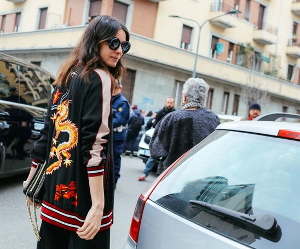
|
|
Instagram has shaken up the
street style business, like it has so many other industries.
AOKI:
The influence of Instagram and Snapchat is difficult to say because
they are in transition. I am not a native user of either. I think
they’ve become just a tool of promotion in Japan now, though they may
have other meanings elsewhere. I think printed images will become like
the harnesses of Hermès. People will make them, but only by special
order. Instagram and Snapchat are Hermès’s bags and scarves, they’re
the moneymakers.
DORÉ: Instagram changed everything because now
an editor didn’t have to wait for us to take a photo and expose the way
they were dressed. The story started being in the hands of the fashion
crowd.
THE BLONDE SALAD’S CHIARA FERRAGNI: Fashion is now much
more democratic thanks to the influence of social media. Now we can all
express our idea of beauty and our taste.
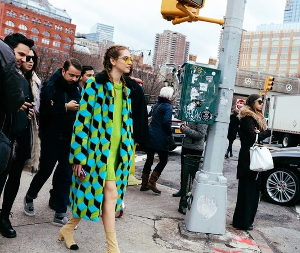
TON: This season was the first that I succumbed to Instagram and
realized that websites are no longer as effective as Instagram.
|
|
On the phenomenon that is The
Blonde Salad:
SCHUMAN:
The reason that Blonde Salad took off? She’s turned on a whole
generation of Italian girls to fashion. “Holy shit, she’s just doing
it, look at her, I want to be her.”
TON: What I didn’t predict
is how certain individuals would be able to leverage their image into
such huge empires. Gary Pepper Girl and The Blonde Salad are mega
global brands now. They were smart to utilize their Insta-fame from the
shows, but from my perspective they aren’t style icons. If any of us
knew this would happen back in 2007 or ’08, we would’ve tried harder.
You could’ve picked Taylor Tomasi or any of those junior editors and
told them, “You don’t have to go down this path, you can style your own
editorials and make yourself the star.” The next thing you know, you’ll
hear The Blonde Salad is designing for, I don’t know, Iceberg.
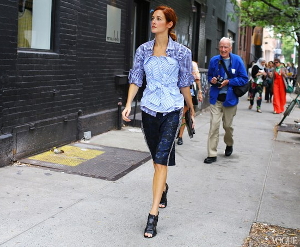
FERRAGNI:
2015 was a turning point for me. I was declared by Forbes as one of the
30 Under 30 Most Influential People, I was on the cover of 27 top
fashion magazines, and Harvard made The Blonde Salad a case study for
their MBA program.
|
|
As the first wave of street
style photographers is nearing the 10-year mark, they’re busy
diversifying into other projects.
SCHUMAN:
The good ones, it’s really changed their life. It’s changed mine. I’ve
got the Sutor Mantellassi shoe thing, I’m designing a premium denim
collection with Roy Rogers.
TON: I was just asked to shoot a
campaign for some donut company at Coachella. I don’t want to be the
guy that’s shooting random street style campaigns until however old I
am. I guess that’s why I started shooting more backstage. I want to
focus more on the clothes.
RODIC: I started to use Snapchat
about a year ago and everyone was so curious about it, so I thought why
not become the Snapchat agency. A Little Nation is a blend between an
ad agency and a production company dedicated to Snapchat. We help
brands to create custom strategies. I’ve been a photographer, a
blogger, and an author, but in some way it was something soft, I guess.
This new project is more ambitious business-wise.
|
|
But Schuman’s first love will
always be street style.
SCHUMAN:
I remember the first time I put a person wearing flip-flops on my blog.
People lost their minds: “That’s so disgusting, how can you walk
through the city like that?” I’d love to know what the flip-flop of
1520 was. We look at [Jacques Henri] Lartigue’s photos now and we have
no idea what everyday people thought of the photos. I love that the
photos we’re taking are appreciated in a contemporary setting, but
they’re also going to tell a really great story 100 years from now.
|
|
One
hundred years from now is one thing, but what about the immediate
future? Where do today’s other top photographers see street style
headed?
SINDING: You have a forest with a million deer
and there’s one pack of wolves. The wolves are eating super well and
they’re making more wolves, and then all of a sudden there’s no more
deer. Eventually the wolves die out and the deer get to come back—the
deer being the showgoers and the wolves being the photographers. We’ve
eaten our way out of balance. A lot of photogs are underselling one
another. Once that happens there will be no money to be made. That
means all those there to make money will go away, and those of us who
love doing this will remain, and it’ll reach a balance again.
RODIC:
When I started it felt like, wow, street style was something very
special. Now there are 500 people doing it. Street style is mainly
Fashion Week style because it’s where the business is, there’s more
money to be made out of shooting people at Fashion Week, and that’s
going to be the main focus in the future. But Scott and hopefully more
people, as a reaction to everyone doing Fashion Week style, will
reinvest in the field of the street and shoot real people as well. I
see a comeback to that. As a pioneer, I feel like I have to go beyond
Fashion Weeks. I think expression happens not just outside shows. I’m
attending Vuela Project, a well-being festival in Ecuador. Just trying
to surprise people.
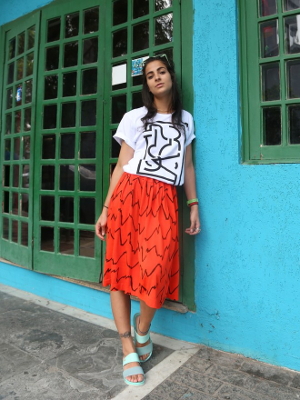
|
|
|
|







